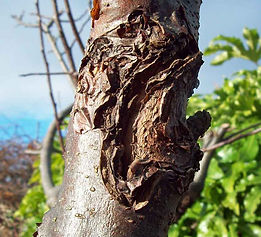Canker: scourge of apples & pears
APPLE canker is a fungal disease my two mature trees have battled with for years.
The Cox's Orange Pippin is badly affected. It's the tree I grew from a pip when I was eight. The James Grieve/Golden Delicious duo tree is only affected on the James Grieve side.
Red Falstaff, the three-year-old in a barrel, is all clear so far.
The fungus Neonectria galligena attacks the bark, causing a sunken area and, eventually, death of the branch. New cankers form from mid-spring.
Sorbus species are attacked as are ash, beech and some other trees. On small branches and fruiting spurs, the infection may girdle the stem and kill it.
On larger branches, cankers are perennial, with the affected area covered with dead bark showing concentric rings.
Older cankers lose the bark, exposing dead wood in the centre. Eventually, the branch will die above the canker, progressively weakened as the bark is killed.
Test your soil's pH
Developing fruits are sometimes attacked and will rot and fall.
Canker is more serious on wet, heavy and/or acid soils, so pay attention to drainage and raise the soil pH by liming if needed. I used a soil-testing kit, about £8 and a worthwhile purchase. My soil turned out to be pH7 - neutral.
You can try to control it chemically with copper-containing fungicides such as Bordeaux mixture, once after picking but before leaf fall and a second time when about half the leaves have fallen.
I'm not keen on this - studies have shown copper compounds build up in the soil and adversely affect helpful predators such as ladybirds and earthworms.
I've learned to live with the canker on the old tree, cutting out the worst and making sure it is in the best health possible - any parasite/predator will attack the weak.

ONE pest on my apple trees is woolly aphid. It looks like mould or mildew, but the insects hide themselves in a mass of white fluff they secrete. They also love Pyracantha and Cotoneaster horizontalis.
Woolly aphids suck sap from woody stems. In the growing season, infested branches are covered with the fluffy white material. Thinner bark around old pruning cuts is a prime site for insects in spring.
Affected branches develop soft, lumpy growths in the bark as a result of feeding. These can split in frosty weather and create entry wounds for canker.
One organic (and physical control) is scrubbing colonies with a stiff brush in spring/early summer before an extensive infestation has built up.
Another method is using an organic winter wash, as nymphs overwinter in cracks in the bark. You can also blast them off with a hose.
Woolly aphid menace
Cutting out canker-affected branches in January.
Organic winter wash & brush-up
ONE chore that's worth doing is using a winter tree wash. The most popular organic sprays are a blend of natural plant and fish oils but you can get garlic-based ones.
Beware - they absolutely stink, and so will you, if you try and apply it on a windy day.
They're used to control overwintering insect pests on fruit trees and bushes. I use Vitax's Winter Tree Wash (about £11). It controls the eggs, larvae and nymphs of aphids and other pests on apples, pears, plums, cherries, gooseberries, blackberries, raspberries, blackcurrants and redcurrants.
Apply during calm, dry conditions using a pump-action sprayer, and thoroughly soak all bark surfaces, especially crooks of branches. If required, a repeat application can be made just prior to bud break in early spring.
Fruit trees pests: canker & woolly aphid
1. CUT out all affected smaller branches and spurs. With larger branches, cut out infected material.
2. Remove all brown, infected bark and wood, cutting back to fresh green tissues.
3. Use protective wound paint immediately, to prevent the wounds becoming reinfected.
Dealing with canker
Canker resistant?
NO variety is completely resistant, but these show some tolerance:
Alfriston, Annie Elizabeth, Brownlees Russet, Cockle Pippin, Crawley Beauty, D’Arcy Spice, Emneth Early, Grenadier, John Standish, Katy (Katya), Lane’s Prince Albert, Lord Derby, Merton Russet, Newton Wonder, Orleans Reinette, Reverend W. Wilkes, Rosemary Russet and Winston.
Most of those are uncommon varieties that you will find at a specialist nursery.
Some popular varieties are particularly susceptible, including Cox’s Orange Pippin, Lord Suffield, James Grieve, Ribston Pippin, Worcester Pearmain, Ellison’s Orange and Spartan.



